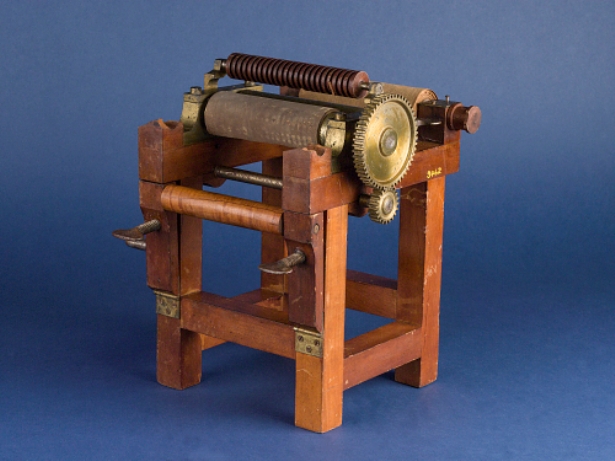Collection: National Museum of American History
Object: Patent Model for the Manufacture of Rubber Fabrics
Maker: Charles Goodyear
Place: New York, New York
Date Made: 1844
On March 9, 1844, the self-taught chemist and inventor Charles Goodyear received patent number 3,462, for the Manufacture of India-Rubber Fabrics (or “Corrugated or Shirred India-Rubber Goods” as he described in his application). Goodyear obsessed over rubber. He tried to find a way to take natural rubber and make it into a stable, durable product—one able to withstand the extremes of cold and heat—for years.
In 1838 Goodyear began experimenting in the abandoned works of the Eagle India Rubber Company of Woburn, Massachusetts. It was here that Goodyear met the company’s former foreman, Nathaniel Hayward, who had also been experimenting with rubber. Building on Hayward’s work, Goodyear discovered, quite by accident, the process of vulcanization in 1839. Goodyear began manufacturing sheet goods in 1841 and spent a further five years perfecting the vulcanization process, patenting his Improvement in India-Rubber Fabrics in June of 1844 (patent number 3,633). This was just months after receiving the patent for the above rubber fabric manufacturing machine and the same year that Goodyear established the Naugatuck India-Rubber Company, in Connecticut.
The machine produced cloth impregnated with rubber by sandwiching rubber strips between swathes of fabric. From 1790 to 1880 the US Patent Office required patent applications be accompanied by a working patent model. These miniature models clearly demonstrated an inventors “new idea” or justification for the patent. Goodyear’s novel idea “was the combining with the calender-rollers an elastic endless apron…and a stretching frame…for the purpose of giving and preserving to the strips or threads their proper tension and allowing them to pass between the laminae of coated cloth.” Though credited as an inventor and a discoverer of the vulcanization process, Charles Goodyear never profited from the revolutionary changes he brought to the rubber industry. Goodyear spent years battling expensive patent-infringement cases, here and abroad, and died heavily encumbered by debt. Charles Goodyear received a burial in Grove Street Cemetery, New Haven, Connecticut.









